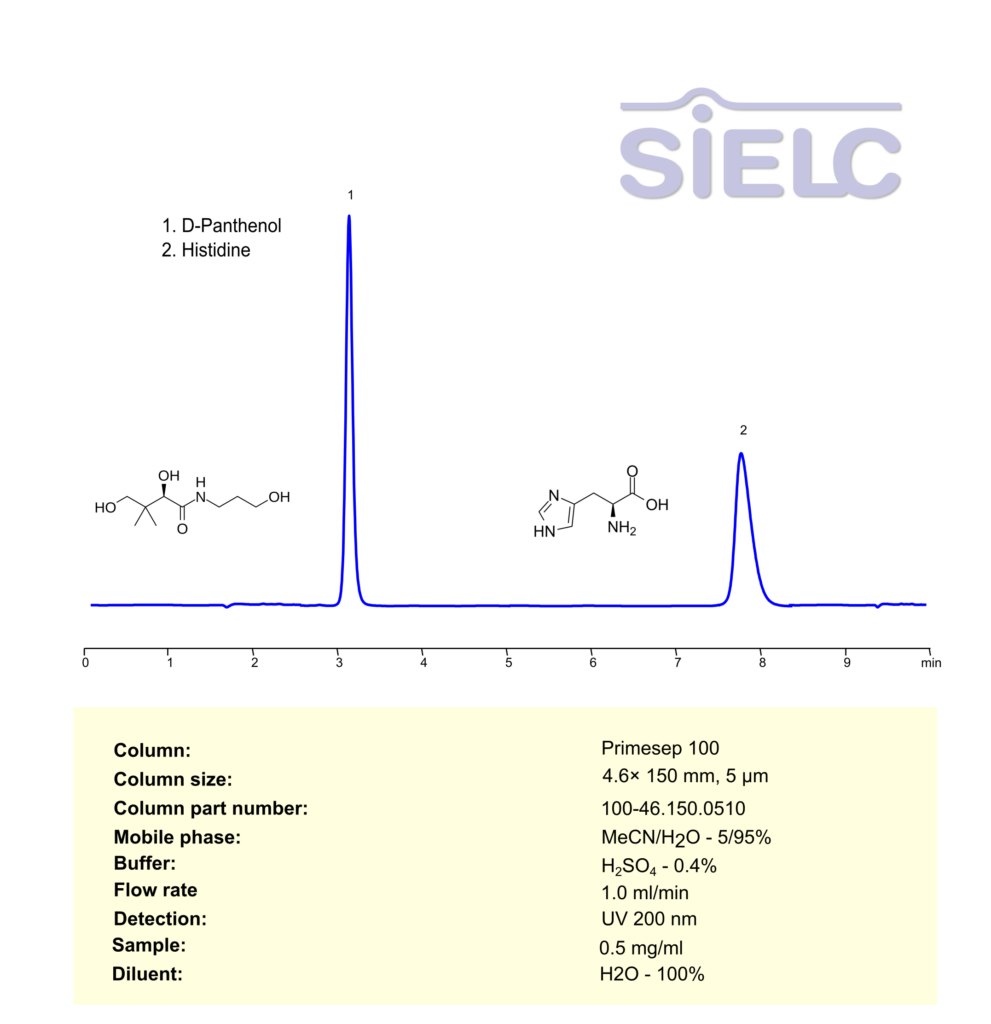High Performance Liquid Chromatography (HPLC) Method for Analysis of Panthenol, Histidine on Primesep 100 by SIELC Technologies
Separation type: Liquid Chromatography Mixed-mode SIELC Technologies

High Performance Liquid Chromatography (HPLC) Method for Analysis of Panthenol, Histidine
D-Panthenol and Histidine are two different compounds that are commonly used in skincare, hair care, and other health-related products due to their beneficial properties.
D-Panthenol (Provitamin B5)
Chemical structure: D-Panthenol is the alcohol form of pantothenic acid (Vitamin B5).
Uses: It is widely used in cosmetics and personal care products for its moisturizing and skin-soothing properties.
Benefits:
Hydration: D-Panthenol is known to improve skin and hair moisture retention.
Skin barrier support: It helps in repairing and strengthening the skin’s barrier function, which is essential for maintaining skin health.
Soothing: It has anti-inflammatory properties, making it beneficial for soothing irritation or minor skin damage.
Healing: D-Panthenol supports wound healing and reduces redness or discomfort associated with sunburn, minor wounds, or rashes.
Hair health: It also coats the hair, improving shine, softness, and strength while reducing the appearance of split ends.
Histidine
Chemical structure: Histidine is an essential amino acid involved in several metabolic processes and is a building block for proteins.
Uses: In the skincare and health sectors, histidine is used for its antioxidant and soothing properties.
Benefits:
Anti-inflammatory: Histidine can help reduce inflammation in the skin, which can be helpful in conditions like eczema or acne.
Antioxidant: It helps protect the skin from oxidative stress caused by free radicals, which can lead to premature aging and damage.
pH regulation: Histidine can help balance the skin’s pH levels, promoting a healthy skin environment.
Skin hydration: By supporting the skin’s natural processes, histidine aids in moisture retention and overall skin smoothness.
Barrier function: It supports the repair and maintenance of the skin’s protective barrier, helping it defend against external irritants.
Both D-Panthenol and Histidine are valuable ingredients in formulations aimed at improving skin hydration, soothing irritation, and maintaining a healthy barrier.
Panthenol, Histidine can be retained, separated and analyzed using a Primesep 100 mixed-mode stationary phase column. The analysis employs an isocratic method with a simple mobile phase comprising water, acetonitrile (MeCN), and sulfuric acid as a buffer. This method allows for detection using UV 200 nm.
| Column | Primesep 100, 4.6 x 150 mm, 5 µm, 100 A, dual ended |
| Mobile Phase | MeCN – 5% |
| Buffer | H2SO4 – 0.4% |
| Flow Rate | 1.0 ml/min |
| Detection | UV 200 |
| Sample | 0.5 mg/mL |
| Diluent | H2O- 100% |
Application Column
Primesep 100
Column Diameter: 4.6 mm
Column Length: 150 mm
Particle Size: 5 µm
Pore Size: 100 A
Column options: dual ended
Panthenol





